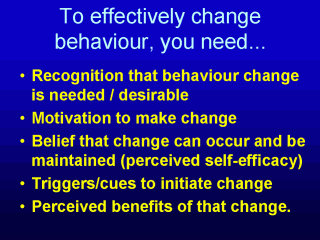| front |1 |2 |3 |4 |5 |6 |7 |8 |9 |10 |11 |12 |13 |14 |15 |16 |17 |18 |19 |20 |21 |22 |23 |24 |25 |26 |27 |28 |29 |review |
 |
Changing attitude is one thing.
The change behaviour requires a different set of factors, many of which we have already
considered. The recognition and motivation to make a change may be present. However, if the person does not believe they will be successful in achieving the change, they will probably not be successful and may not even try. This is perceived self-efficacy. It refers to the belief that you can be effective when you attempt things and will be successful. Compared to people who perceive themselves as having low self-efficacy, those who perceive high self-efficacy will try harder, and keep trying longer in the face of repeated failure. As a result, they more often succeed than do those with low perceived self-efficacy. Other important components are some trigger or cue to initiate change and a clear sense of what benefits will occur as a result of making the change. |